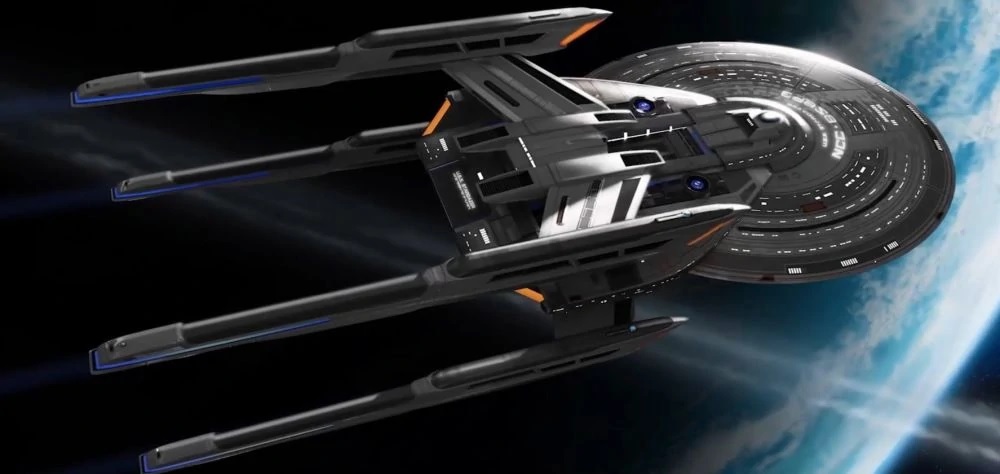Sagan Class
Created by Captain Zseeq on Sun Dec 10th, 2023 @ 12:06am
Sagan Class
 | |
| Affiliation: | Federation Starfleet |
| Service Period: | 24th - 25th Centuries |
| Length: | 540 meters |
| Width: | 342 meters |
| Height: | 155 meters |
| Mass: | 1,787,850 metric tons |
| Decks: | 16 |
| Crew: | 500 personnel |
| Speed: | Warp 9.99 |
| Armament: | Phaser Arrays Torpedo Launchers |
| Defenses: | Multiphasic Shielding |
| Auxiliary craft: | Starfleet Shuttlecraft |
Overview
Following the horrors of the Dominion War many Admirals at Starfleet Command wanted to focus on building larger vessels to make up for Starfleet’s losses; however, the damage to Starfleet was far more serious than many realized and chose to admit. Facing both a resource and troop shortage, the Starfleet Corps of Engineers began to field smaller, specialized designs to fulfill specialist duties throughout the galaxy. These ships would be fast, tough vessels that would rely on automation for many functions. One of the first vessels designed as part of this new project was the Federation's Sagan Class.
Designed with a myriad of dedicated supplemental subsystems, an enhanced communications array on par with some communications relay stations, and an enhanced propulsion system the Sagan was intended to take on flagship responsibilities for this new line of starships. Nevertheless, as designs were refined on other vessels being developed as part of the same initiative, the Sagan was reassigned to serve as an exploratory vessel. Construction of an initial order of three vessels would begin on Stardate 58839.0 in the year 2381; however, Stargazer would launch prior to its class namesake due to construction delays.
Capabilities
Designed with efficiency in mind, the Sagan features an integrated unibody design in which the primary and engineering sections are directly merged into one structure. Atypical for most Starfleet vessels, the Sagan would sport four warp nacelles like its Cardenas, Cheyenne, and Constellation class ancestors. While Starfleet had only minor success with vessels featuring a four nacelle arrangement, the Corps of Engineers revisited work on the nacelle structure of the Cheyenne Class for inspiration for their next generation nacelles. Structurally, field stabilizers were placed first in the nacelle design, diminishing the strain on the warp field generator coils located behind. This format allows the Sagan to maintain high speeds for long periods, but at the expense of high power demands.
Following the modular design of this generation of vessels, the Sagan Class has a similar interior layout as its sister ships and has a darker, metallic appearance than previous generations of starship. While crew support remains a priority, accommodations of the Sagan Class are modest compared to those of the 24th Century. Officer Quarters on a Sagan Class vessel are the equivalent of cabins used by lower seniority personnel on a Galaxy Class ship. While rated for diplomatic assignments, visiting Ambassadors utilize the same accommodations. The design features a large gymnasium, multiple mess halls, and holosuites for crew relaxation.
Well armed and defended, Sagan Class starships are loaded with modern Phaser and Torpedoes for use while on tactical assignments. Primary defenses are provided from a Deflector Dish installed on the underside of the vessel's saucer section. Sagan Class vessels utilize Multiphasic Shields for protection during attack or during specialized missions as this shield modulates through multiple energy spectrums, enhancing protection and recharge rates. Outfitted with the latest sensor pallets and advanced laboratories, all these attributed combined make the Sagan is ideal for long-range exploratory missions.
Refits and Variants
Following the opening of formal trade relations with the Romulan Free State, the Starfleet Corps of Engineers began work on Project Stargazer, a Sagan Class refit project that would employ technology reverse engineered from components salvaged from the Borg Cube Artifact.
Mission Profiles
Multirole Explorer, Scientific and Survey Operations, Strategic and Diplomatic Operations. Due to the diverse equipment installed into the design, the Sagan Class is an ideal choice for a variety of mission profiles.
Naming Conventions
Like its ancestors in the Constellation Class, members of the Sagan Class are commonly named after astronomers, constellations, and mythology.
Notable Starships
- U.S.S. Sagan, Class Prototype
- U.S.S. Ashland
- U.S.S. Chawla
- U.S.S. Explorer
- U.S.S. Stargazer
Categories: No categories found